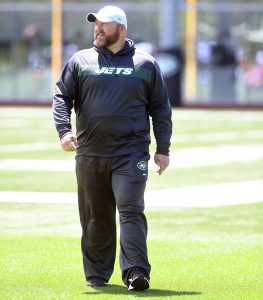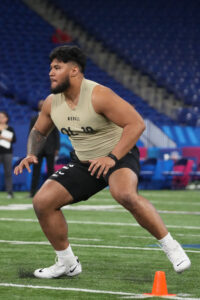Bringing in 11 offensive linemen on “30” visits, the Steelers did not mask their intentions in the first round. They ended up capitalizing on this tackle-rich draft class, selecting Washington’s Troy Fautanu at No. 20 overall.
 Fautanu is the second straight tackle the Steelers have chosen in Round 1, as the team traded up for Broderick Jones (No. 14 overall) last year. Some teams viewed Fautanu as a player who will be a better guard, but Mike Tomlin said (via ESPN.com’s Brooke Pryor) the Steelers view their most recent addition as a player who can stick at tackle.
Fautanu is the second straight tackle the Steelers have chosen in Round 1, as the team traded up for Broderick Jones (No. 14 overall) last year. Some teams viewed Fautanu as a player who will be a better guard, but Mike Tomlin said (via ESPN.com’s Brooke Pryor) the Steelers view their most recent addition as a player who can stick at tackle.
Daniel Jeremiah’s NFL.com big board slotted Fautanu 11th, and while some clubs envisioned the Washington alum as a player who will need to move inside, the longtime draft analyst does not. Some NFL personnel agree with this viewpoint; it would appear the Steelers are in this camp. This positions Fautanu as a player who will join Jones and Dan Moore at tackle. Moore is in a contract year, and the three-year starter appears set to be out of Pittsburgh by 2025 (at the latest) as a result of this pick.
The Steelers are believed to be ready to slide Jones from right to left tackle, his primary college position. This would open up the right side for Fautanu, who spent most of his college career at left tackle (with a few guard starts mixed in). If Jones moves over, the Steelers will be asking a left tackle — either Jones or Fautanu — to shift positions. The Steelers view Fautanu, despite his arrival six spots after where Jones was chosen last year, as a better prospect compared to the Georgia alum, The Athletic’s Mark Kaboly notes (subscription required). Trade options presented themselves for the Steelers, but they stood down due to the value they believed Fautanu can provide.
Fautanu figures to complement Pittsburgh’s guard tandem (James Daniels, Isaac Seumalo) rather than threaten one of the starters’ jobs, and Kaboly goes a step further by noting the team is likely to come to an extension agreement with Daniels before Week 1. Daniels is going into the final season of a three-year, $26.5MM deal.
 Despite going into his seventh NFL season, Daniels will not turn 27 until September. The former Bears second-rounder would profile as a player who has several prime years remaining, making him a good candidate for a lucrative third contract. Pro Football Focus rated the Iowa alum 33rd among guards last season and 24th in his Steelers debut. Daniels has played both guard and center as a pro, though a Bears effort to install him at center did not last beyond the 2019 season. He has operated as the Steelers’ right guard for the past two seasons.
Despite going into his seventh NFL season, Daniels will not turn 27 until September. The former Bears second-rounder would profile as a player who has several prime years remaining, making him a good candidate for a lucrative third contract. Pro Football Focus rated the Iowa alum 33rd among guards last season and 24th in his Steelers debut. Daniels has played both guard and center as a pro, though a Bears effort to install him at center did not last beyond the 2019 season. He has operated as the Steelers’ right guard for the past two seasons.
The Steelers have both Daniels and Semualo signed to deals south of $10MM per year; a Daniels extension would probably change that. With the Steelers having both Russell Wilson and Justin Fields on low-cost deals, more flexibility to spend exists. With two rookie-contract tackles in place (and no starter-caliber center on the roster as of yet), Daniels may be set to benefit soon. The Steelers do not negotiate extensions in-season, so Week 1 would double as a deadline for the team and the contract-year RG.



